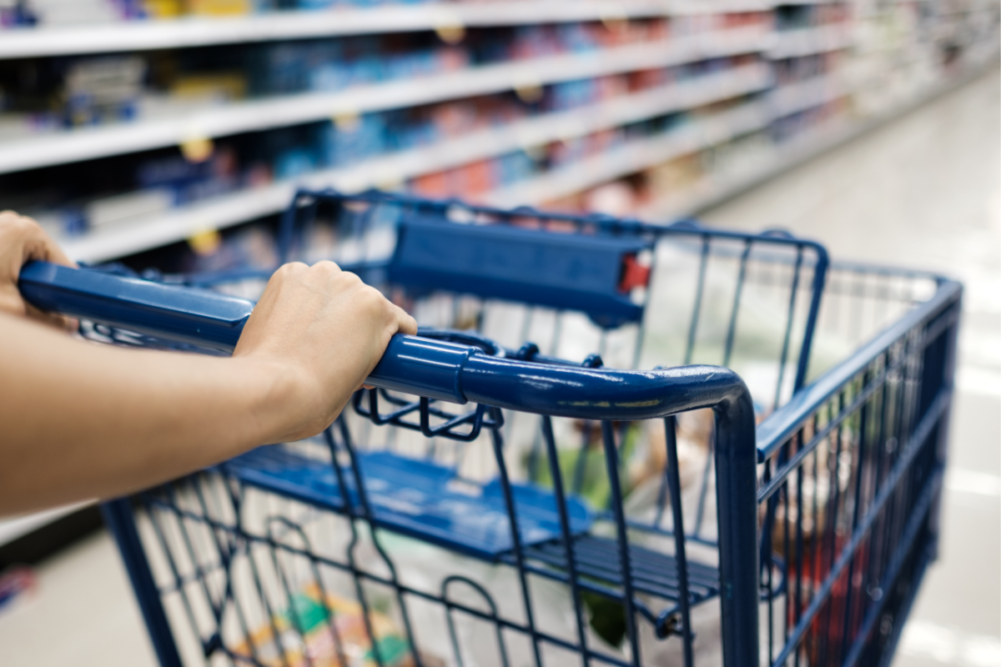CHICAGO — Private brands are projected to take 7% of US dollar market share from national brands by the end of this decade, according to the Kearney 2024 Private Label Report.
The study, a collaboration of Kearney and NielsenIQ (NIQ), forecast private label to account for 24% of dollar sales across the food and beverage, household essentials, beauty and personal care, and fashion and apparel categories by 2030, with national brands representing 76% of sales. Last year, private brands were 17% of dollar sales in those categories versus an 83% share for national brands.
By dollars, private label rose 12% to $225 billion of those category sales in 2023 from $201 billion in 2022, said the Kearney-NIQ report, released last week. Based on NIQ data, the private label market by 2030 will grow to an estimated $406 billion according to its “legacy shelf presence,” to $498 billion in a “sustained aisle conquest” and to as much as $585 billion in an “omnichannel blitz” across in-store and digital channels, the researchers said.
Rising consumer affinity for private labels is driving store brand share growth. In 2023, 53% of consumers cited private brands as “very or extremely important” to their store choice — up from 46% in 2019 and 35% in 2016 — and that percentage stands to top 60% of shoppers by 2030, Kearney-NIQ predicted.
Consumers: Private label on par with national brands in quality
Food and beverages are leading the way, with 30% of consumers rating private label quality as superior to that of national brands, compared with 29% for fashion and apparel, 28% for beauty and personal care and 26% for household essentials.
More than half of shoppers ranked store brands as having similar quality to national brand counterparts in food and beverages (55%), household essentials (59%) and personal care (53%), while just under half (46%) thought so with beauty care and fashion/apparel.
Only 2% of consumers rated private label as inferior and 13% as slightly inferior to name brands in quality for both food and beverages and household essentials. That compared with 2% inferior and 16% slightly inferior in personal care, 5% inferior and 20% slightly inferior in fashion/apparel, and 6% inferior and 20% slightly inferior in beauty care.
The findings show that, in most categories, consumers discern little difference between private and national brands in quality, according to the Kearney-NIQ report.
“Private label can no longer be considered the poor cousin of major national brands,” said Katherine Black, a Kearney partner and the study’s lead author. “We found that retailers are now investing in private brands as a differentiator. More than half of consumers rank private brands as a very important factor in their store choice, a number we project to be more than 6 in 10 by 2023. Additionally, though the branded market remains significantly larger than the private label market, private label is outperforming branded products by 3% across both online and in-store channels.”
In food, private brands gaining share
Among food categories for 2023, bakery held the largest private label share at 56.7% in dollars (down 1% year over year) and 42.4% in units (up 1%), the study said.
Next among food categories with at least 10% private brand share were dairy at 34.6% in dollars (up 2.5%) and 37% in units (up 3.1%), deli at 27.1% in dollars (up 2%) and 28.5% in units (up 2.2%), meat at 24% in dollars (up 3.9%) and 24.8% in units (up 1.6%), frozen at 23.7% in dollars (up 0.4%) and 23.9% in units (up 1.7%), produce at 16.4% in dollars (up 5%) and 18.9% in units (up 3.8%), and grocery at 14.3% in dollars (up 4.4%) and 10.5% in units (up 5%).
Over two-thirds of consumers across income levels have a favorable opinion of private label products, including 68% of high incomes ($100,000 annually or more), 67% of middle incomes ($50,000 to $99,000) and 66% of low incomes (less than $50,000). The result is similar across generations of consumers, with 70% of Generation Z holding positive sentiment toward private label versus 68% of Generation X and 65% of baby boomers.
Still, the United States trails Europe in private label penetration at only 17% for 2023, compared with 52% for Switzerland, 46% for the United Kingdom, 37% for Germany, 34% for The Netherlands, 33% for France and 31% for Italy, despite being relatively on par with Canada at 19%, according to the report.
Compared to the UK’s mature private label market, US store brands have the most growth potential in food categories such as meat, prepared foods, salty snacks, vegetables, fruit, cheese, desserts, cookies and crackers, seafood, bread and pasta/rice, Kearny-NIQ said.
“The US lags behind European countries in private label penetration, signaling a major opportunity for grocery retailers,” Black said. “Private label can generate significant margin for US retailers, while possibly posing potential risk for CPG companies as the mix shifts away from national brands. Companies need to pay attention to growing private label offerings — quickly being adopted by Gen Z and higher income consumers — before it’s too late.”

